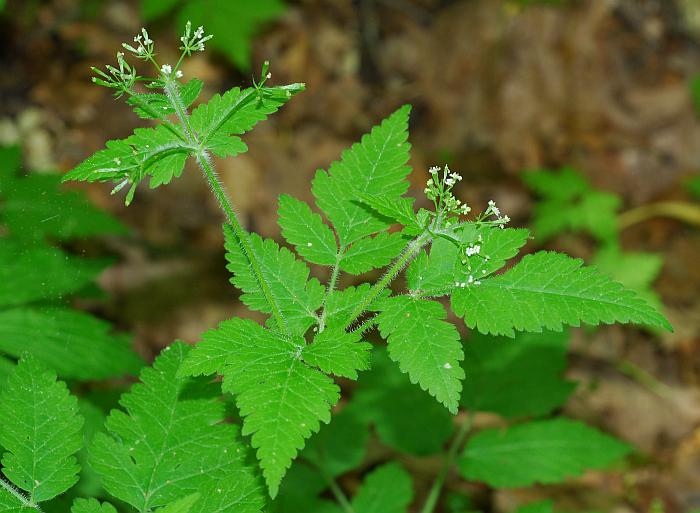Osmorhiza claytonii (Michx.) C.B. Clarke
Sweet Cicely

Native
CC = 3
CW = 3
MOC = 42
© SRTurner
Osmorhiza claytonii (Michx.) C.B. ClarkeSweet Cicely | |
 |
Native CC = 3 CW = 3 MOC = 42 |
© SRTurner |
|
Family - Apiaceae Habit - Perennial forb with somewhat tuberous-thickened roots. Anise scent weak or absent. Stem - Ascending, to 90 cm, sometimes from a spreading base, sparsely to more commonly densely pubescent with spreading hairs, rarely glabrous.
Leaves - Alternate and often basal, petiolate, the uppermost sessile or nearly so, the sheathing bases not or only weakly inflated. Blades to 30 cm long, broadly ovate to triangular-ovate in outline, ternately or ternately then pinnately 2 or 3 times compound with distinct leaflets, these mostly 1 cm or more wide, 3-8 cm long, ovate to lanceolate, shallowly to moderately several-lobed and sometimes also with a pair of deep, basal lobes, the margins also toothed, shallowly cordate to long-tapered at the base, narrowed or tapered to a sharp point at the tip, the upper and undersurface sparsely to moderately pubescent with stiff, spreading hairs, especially along the main veins and margins.
Inflorescences - Terminal and axillary, compound umbels, mostly long-stalked, the umbellets sometimes all or partially of staminate flowers. Involucre of 1-6 bracts, rarely absent, the bracts 3-20 mm long, usually reflexed, linear to lanceolate, with a sharply pointed tip, densely pubescent with stiff, spreading or ascending hairs along the margins and midvein. Rays 3-6, 2-8 cm long, often somewhat unequal in length, usually ascending. Involucel of 4-7 bractlets, these shorter than the flower stalks, similar to the bracts.
Flowers - 7-19 in each umbellet (usually 7 or fewer perfect, the rest staminate), the stalks 2-5 mm long at flowering (the central flower usually sessile and staminate), those of the perfect flowers elongating to 12 mm at fruiting. Sepals absent. Petals oblanceolate to obovate, rounded or with an abrupt, minute point at the tip, white. Ovaries glabrous or hairy.
Fruits - Schizocarps, linear to narrowly oblong-oblanceolate, long-tapered at the base, tapered to a beak at the tip, flattened laterally, glabrous or pubescent with stiff, ascending hairs (bristles) along the ribs, greenish brown to dark brown or black with green to dark brown ribs, the mericarps sometimes slightly arched or curved, somewhat narrowed along the commissures, with 5 narrow, angled ribs, these lacking wings.
Flowering - April - June. Habitat - Mesic and bottomland forests, ravines, streambanks. Origin - Native to the U.S. Lookalikes - Osmorhiza longistylis. Other info. - This species is found across most of Missouri, but although it is far from rare, it seems to be much less common in the state than its sibling O. longistylis. Its North American distribution includes much of the eastern half of the U.S. (excluding a few far southern states) and Canada. Photographs taken at Meramec State Park, Franklin County, MO, 5-7-2019 (SRTurner). |